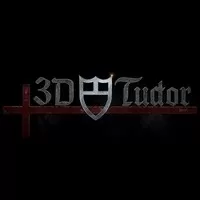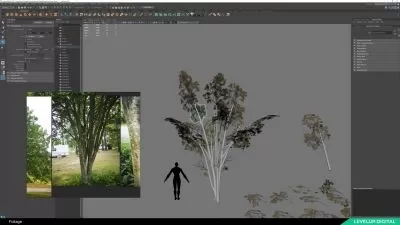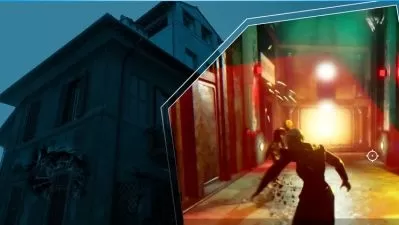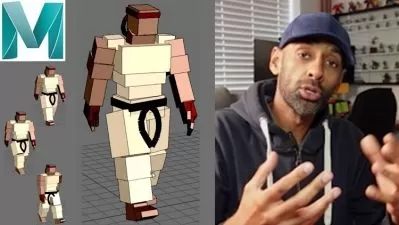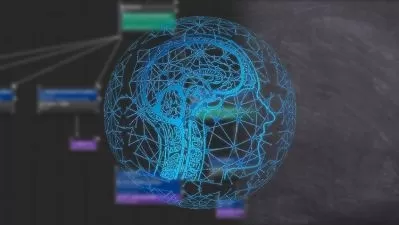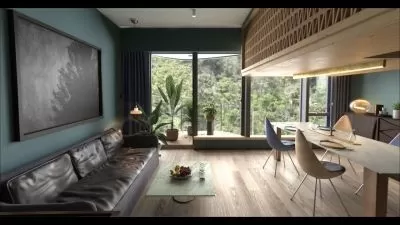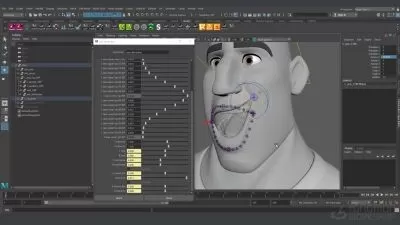Unreal Engine 5 Blueprint Coding for Beginners
3D Tudor,Markos Resvanis
5:09:23
Description
Unreal Engine 5 Blueprint Coding for Beginners: Procedural Minigame
What You'll Learn?
- • Completing an introduction to Unreal Engine 5 (UE5) for coding for video games
- • Developing your understanding of UE5 blueprints and the logic of scripting to create complex game mechanics and interactions
- • Creating a puzzle game that involves completing a set of mini-games using blueprints and other UE5 tools
- • Setting up a basic User Interface (UI) set up for your game, including buttons for starting, pausing, and quitting the game
- • Understanding and handling game-over scenarios, restarting the game, and maintaining a proper hierarchy for a smooth gameplay experience
- • Implementing direct inputs to a blueprint and using them to control a non-possessable actor, such as a camera or an interactive object
- • Learning methods for organising and manipulating data and variables within your game, including arrays and maps
- • Experimenting with mouse events and inputs for enhanced player interaction with the virtual environment
- • Modifying and enhancing existing game mechanics, and introducing new ones to add depth and complexity to your game
- • Exploring methods for animating objects using vector scripting with blueprints, including controlling position and rotation
- • Manipulating text and creating password mechanics for enhanced game system options
- • Exploring advanced focus mechanics that enable focus on individual parts using modular pieces to increase your game's complexity
Who is this for?
What You Need to Know?
More details
DescriptionUnreal Engine 5 Blueprint Coding for Beginners
Are you a game designer, programmer or video game coder looking to create a truly seamless player interactive experience?
Look no further than our newest venture into the world of using blueprints in Unreal Engine 5, where we'll take you through every step of the process of creating a variety of game scenarios and widget mechanics.
Introduction
Coding for video games is an essential skill that complements the artistic abilities of 3D art enthusiasts and hobbyists. Understanding the fundamentals of coding enables you to breathe life into your creations and unlock a new realm of creative possibilities.
Whether you want to develop games or collaborate with game developers, coding allows you to shape the gameplay mechanics, implement stunning visual effects, and craft unique experiences. This is where our newest course comes in!
'Unreal Engine 5 Blueprint Coding for Beginners: Procedural Minigame' will see us explore how to use blueprints to create a series of mini-games and weave them into a unified game experience. We will also venture into creating a user interface (UI) for a game, allowing players to start, pause, quit, and monitor their winning or losing status.
Your 'Unreal Engine 5 Blueprint Coding for Beginners: Procedural Minigame' journey will start with setting up the game mode and camera and laying the foundation for your project. The environment and its assets are already set up for you, so we can concentrate on creating blueprints. We delve into blueprint frameworks and enabling inputs for seamless player interaction, and then move on to creating inputs for bomb rotation to introduce core movement mechanics.
As we progress, we will navigate through advanced topics such as bomb timer frameworks and implementing timer countdowns, always ensuring a logical sequence and clear explanations to tackle any obstacles.
This course will teach you everything you need to know about bringing your game ideas to life through a fully functional puzzle game in just over 5 hours of 3D game art and coding.
Our ‘Blueprint Coding for Beginners: Procedural Minigame’ top 6 points:
1. Developing your understanding of UE5 blueprints and the logic of scripting to create complex game mechanics and interactions
2. Creating a puzzle game that involves completing a set of mini-games using blueprints and other UE5 tools
3. Setting up a basic User Interface (UI) set up for your game, including buttons for starting, pausing, and quitting the game
4. Implementing direct inputs to a blueprint and using them to control a non-possessable actor, such as a camera or an interactive object
5. Learning methods for organising and manipulating data and variables within your game, including arrays and maps
6. Exploring methods for animating objects using vector scripting with blueprints, including controlling position and rotation
Your project will involve experimenting with various elements such as creating blueprints, vector animations, mouse events, inputs, and complex mechanics. Following our course lessons, you will delve into the exciting world of Unreal Engine 5 (UE5).
‘Blueprint Coding for Beginners: Procedural Minigame’ offers a range of mechanics to explore, each designed to challenge and enhance your skills. You will learn how to craft intricate blueprints, enabling you to bring your ideas to life through logical scripting and functionality.
Additionally, you will master the art of vector animations, infusing your creations with dynamic and fluid movements. Mouse events and inputs will be at your disposal, empowering you to interact with your virtual environments in innovative ways. To add depth and complexity to your projects, you can modify and enhance existing mechanics or introduce entirely new ones.
By customizing their intricacy and interplay, you will breathe life into your UE5 experiences, continuously evolving alongside your growing skillset.
Course Overview
Are you ready to take your game design and coding skills to the next level or begin a thrilling journey of programming video games from zero to hero?
Part of your learning will also include handling game-over scenarios, restarting the game, summarising mechanics, always maintaining a keen eye for a proper hierarchy, and addressing any errors for a smooth gameplay experience.
As you progress through ‘Blueprint Coding for Beginners: Procedural Minigame’, we will regularly summarise and reflect on what we've accomplished, reinforcing your understanding of key concepts. This includes crucial elements like UI framework design, start/quit game functionality, and game pausing mechanisms.
‘Blueprint Coding for Beginners: Procedural Minigame’ covers a diverse set of learning opportunities, such as
1. Composing the bomb piece by piece
2. Adding lights for win indications and highlights for selection
3. Explaining design choices
4. Effective navigation of the viewport hierarchy
We also emphasize data management, and the importance of hierarchy, creating data arrays, and ensuring a robust system for handling essential game data. ‘Blueprint Coding for Beginners: Procedural Minigame’ will teach you the importance of data management, manipulating text, and creating password mechanics.
You will also find out about hovering mechanics (i.e., mouse-over events), and implementing custom events for enhancing interactivity, with a focus on the click-on-highlight feature. This allows players to focus on specific parts of objects, with detailed guidance and binding actions provided to enrich the gameplay.
‘Blueprint Coding for Beginners: Procedural Minigame’ will finish with an exploration of advanced focus mechanics, enabling focus on individual parts using modular pieces. This will make sure that you gain a comprehensive understanding of this feature, thereby enhancing your game's complexity.
Course Structure and Delivery
'Unreal Engine 5 Blueprint Coding for Beginners: Procedural Minigame' helps you practice what you've learned. You'll have access to the course materials at any time, so you can learn at your own pace and on your schedule.
Each part of the course includes multiple video lessons that cover specific topics in detail.
Who Should Take This Course?
Our new video game adventure is designed for anyone who wants to create a fully functional puzzle game in Unreal Engine 5, whether you're a beginner or an experienced game designer. 'Unreal Engine 5 Blueprint Coding for Beginners: Procedural Minigame' is ideal for:
- Anyone who wants to explore the fundamentals of making puzzle games using an actionable project in Unreal Engine 5
- Game designers and programmers who want to take their UE5 coding skills to the next level to create interactive 3D mini-games
- Artists who want to specialize in game design and programming for games or other virtual experiences using blueprints in Unreal Engine 5
The 'Unreal Engine 5 Blueprint Coding for Beginners: Procedural Minigame' resource pack includes 82 static meshes, 17 texture maps, 30 PBR materials, 1 text font, and 1 Niagara particle setup.
Summing it all up
Creating playable mini-games in Unreal Engine 5 is an art form, and with 'Unreal Engine 5 Blueprint Coding for Beginners: Procedural Minigame', you can begin to understand it. Whether you're a beginner or an inexperienced game designer, our course will give you the skills and knowledge you need to create an immersive and breathtaking puzzle game.
By the end of 'Unreal Engine 5 Blueprint Coding for Beginners: Procedural Minigame', you will acquire extensive knowledge in game development with Unreal Engine 5. From blueprint scripting to interactive mechanics, you will be well-equipped with the skills needed to bring your game ideas to life. You'll also have a fully functional puzzle game, designed with replayability in mind, which you can share with friends and family or use as a foundation for your future game development projects.
Join us on this transformative journey and take the first step towards creating video games in Unreal Engine 5 in just 38 lessons!
Until next time, happy modelling everyone!
Neil - 3D Tudor
Who this course is for:
- - Anyone who wants to explore the fundamentals of making puzzle games using an actionable project in Unreal Engine 5
- - Game designers and programmers who want to take their UE5 coding skills to the next level to create interactive 3D mini-games
- - Artists who want to specialize in game design and programming for games or other virtual experiences using blueprints in Unreal Engine 5
Unreal Engine 5 Blueprint Coding for Beginners
Are you a game designer, programmer or video game coder looking to create a truly seamless player interactive experience?
Look no further than our newest venture into the world of using blueprints in Unreal Engine 5, where we'll take you through every step of the process of creating a variety of game scenarios and widget mechanics.
Introduction
Coding for video games is an essential skill that complements the artistic abilities of 3D art enthusiasts and hobbyists. Understanding the fundamentals of coding enables you to breathe life into your creations and unlock a new realm of creative possibilities.
Whether you want to develop games or collaborate with game developers, coding allows you to shape the gameplay mechanics, implement stunning visual effects, and craft unique experiences. This is where our newest course comes in!
'Unreal Engine 5 Blueprint Coding for Beginners: Procedural Minigame' will see us explore how to use blueprints to create a series of mini-games and weave them into a unified game experience. We will also venture into creating a user interface (UI) for a game, allowing players to start, pause, quit, and monitor their winning or losing status.
Your 'Unreal Engine 5 Blueprint Coding for Beginners: Procedural Minigame' journey will start with setting up the game mode and camera and laying the foundation for your project. The environment and its assets are already set up for you, so we can concentrate on creating blueprints. We delve into blueprint frameworks and enabling inputs for seamless player interaction, and then move on to creating inputs for bomb rotation to introduce core movement mechanics.
As we progress, we will navigate through advanced topics such as bomb timer frameworks and implementing timer countdowns, always ensuring a logical sequence and clear explanations to tackle any obstacles.
This course will teach you everything you need to know about bringing your game ideas to life through a fully functional puzzle game in just over 5 hours of 3D game art and coding.
Our ‘Blueprint Coding for Beginners: Procedural Minigame’ top 6 points:
1. Developing your understanding of UE5 blueprints and the logic of scripting to create complex game mechanics and interactions
2. Creating a puzzle game that involves completing a set of mini-games using blueprints and other UE5 tools
3. Setting up a basic User Interface (UI) set up for your game, including buttons for starting, pausing, and quitting the game
4. Implementing direct inputs to a blueprint and using them to control a non-possessable actor, such as a camera or an interactive object
5. Learning methods for organising and manipulating data and variables within your game, including arrays and maps
6. Exploring methods for animating objects using vector scripting with blueprints, including controlling position and rotation
Your project will involve experimenting with various elements such as creating blueprints, vector animations, mouse events, inputs, and complex mechanics. Following our course lessons, you will delve into the exciting world of Unreal Engine 5 (UE5).
‘Blueprint Coding for Beginners: Procedural Minigame’ offers a range of mechanics to explore, each designed to challenge and enhance your skills. You will learn how to craft intricate blueprints, enabling you to bring your ideas to life through logical scripting and functionality.
Additionally, you will master the art of vector animations, infusing your creations with dynamic and fluid movements. Mouse events and inputs will be at your disposal, empowering you to interact with your virtual environments in innovative ways. To add depth and complexity to your projects, you can modify and enhance existing mechanics or introduce entirely new ones.
By customizing their intricacy and interplay, you will breathe life into your UE5 experiences, continuously evolving alongside your growing skillset.
Course Overview
Are you ready to take your game design and coding skills to the next level or begin a thrilling journey of programming video games from zero to hero?
Part of your learning will also include handling game-over scenarios, restarting the game, summarising mechanics, always maintaining a keen eye for a proper hierarchy, and addressing any errors for a smooth gameplay experience.
As you progress through ‘Blueprint Coding for Beginners: Procedural Minigame’, we will regularly summarise and reflect on what we've accomplished, reinforcing your understanding of key concepts. This includes crucial elements like UI framework design, start/quit game functionality, and game pausing mechanisms.
‘Blueprint Coding for Beginners: Procedural Minigame’ covers a diverse set of learning opportunities, such as
1. Composing the bomb piece by piece
2. Adding lights for win indications and highlights for selection
3. Explaining design choices
4. Effective navigation of the viewport hierarchy
We also emphasize data management, and the importance of hierarchy, creating data arrays, and ensuring a robust system for handling essential game data. ‘Blueprint Coding for Beginners: Procedural Minigame’ will teach you the importance of data management, manipulating text, and creating password mechanics.
You will also find out about hovering mechanics (i.e., mouse-over events), and implementing custom events for enhancing interactivity, with a focus on the click-on-highlight feature. This allows players to focus on specific parts of objects, with detailed guidance and binding actions provided to enrich the gameplay.
‘Blueprint Coding for Beginners: Procedural Minigame’ will finish with an exploration of advanced focus mechanics, enabling focus on individual parts using modular pieces. This will make sure that you gain a comprehensive understanding of this feature, thereby enhancing your game's complexity.
Course Structure and Delivery
'Unreal Engine 5 Blueprint Coding for Beginners: Procedural Minigame' helps you practice what you've learned. You'll have access to the course materials at any time, so you can learn at your own pace and on your schedule.
Each part of the course includes multiple video lessons that cover specific topics in detail.
Who Should Take This Course?
Our new video game adventure is designed for anyone who wants to create a fully functional puzzle game in Unreal Engine 5, whether you're a beginner or an experienced game designer. 'Unreal Engine 5 Blueprint Coding for Beginners: Procedural Minigame' is ideal for:
- Anyone who wants to explore the fundamentals of making puzzle games using an actionable project in Unreal Engine 5
- Game designers and programmers who want to take their UE5 coding skills to the next level to create interactive 3D mini-games
- Artists who want to specialize in game design and programming for games or other virtual experiences using blueprints in Unreal Engine 5
The 'Unreal Engine 5 Blueprint Coding for Beginners: Procedural Minigame' resource pack includes 82 static meshes, 17 texture maps, 30 PBR materials, 1 text font, and 1 Niagara particle setup.
Summing it all up
Creating playable mini-games in Unreal Engine 5 is an art form, and with 'Unreal Engine 5 Blueprint Coding for Beginners: Procedural Minigame', you can begin to understand it. Whether you're a beginner or an inexperienced game designer, our course will give you the skills and knowledge you need to create an immersive and breathtaking puzzle game.
By the end of 'Unreal Engine 5 Blueprint Coding for Beginners: Procedural Minigame', you will acquire extensive knowledge in game development with Unreal Engine 5. From blueprint scripting to interactive mechanics, you will be well-equipped with the skills needed to bring your game ideas to life. You'll also have a fully functional puzzle game, designed with replayability in mind, which you can share with friends and family or use as a foundation for your future game development projects.
Join us on this transformative journey and take the first step towards creating video games in Unreal Engine 5 in just 38 lessons!
Until next time, happy modelling everyone!
Neil - 3D Tudor
Who this course is for:
- - Anyone who wants to explore the fundamentals of making puzzle games using an actionable project in Unreal Engine 5
- - Game designers and programmers who want to take their UE5 coding skills to the next level to create interactive 3D mini-games
- - Artists who want to specialize in game design and programming for games or other virtual experiences using blueprints in Unreal Engine 5
User Reviews
Rating
3D Tudor
Instructor's CoursesMarkos Resvanis
Instructor's Courses
Udemy
View courses Udemy- language english
- Training sessions 38
- duration 5:09:23
- Release Date 2023/07/05





